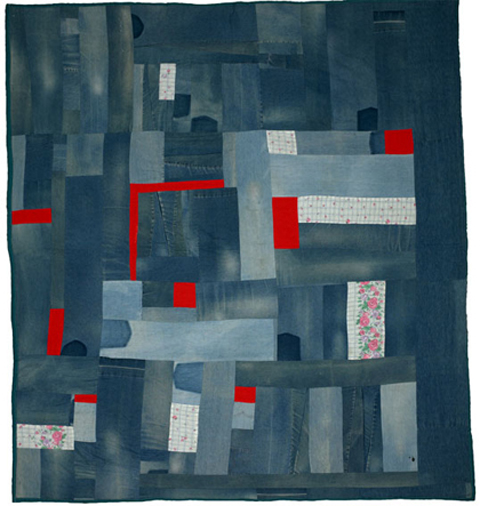I have been entrusted with the Quilt section of this blog and I think I want to give a greater understanding of quilts and the history implicit therein before I can talk about people who are shaking it up currently.
The Quilts made by the ladies of Gee’s Bend, Alabama have toured the world to much critical acclaim and some skepticism. I think they are a really great crash course in quilt history. This is because they have an entire history viewable in less than a century of work by the generations of an isolated community set in the bend of a river.

Think of the history of craft as function. Think of quilts as utility. Its easy to see how then clothes and fabric that have been worn past their function become the foundation for the quilts. This example includes all the fabric at hand including the fabric off an old mattress. this quilt is from 1938 by Rachey Carey George.

Look closely at the lines of the sewing, straight lines following the seams to keep the pieces together. The quilting follows the same intention, keep all the pieces together so it can be used on the bed. this one is from 1950 by quilter Lutisha Pettway:

Form follows function.
A simple logical step in the formation of any creation based in use or function.
Now give this process a hundred years, add a few generations of practice and what do you get? Innovation and variation.
Take this next quilt. The sewing following the fabric strips has been turned every 90 degrees to form a square pattern. like this one from 1963 by quilter Loretta Pettway:

This is a simple variation on the stripes, taking the same process of following the fabric as it lays only working from the center instead of the side
Now you can watch these techniques add to each other and generate others. for example this one from 1976 by Annie Mae Young:

What we see is the simple lines of quilting for function add complexity with practice and innovation as young women in this community grow up and take the banner from their mothers and grandmothers by adding their own expression as a layer to the forms expressed by those they learned from.
Here is a quilt from 2002 showing what I agree with the New York Times is “some of the most miraculous works of modern art America has produced.” by quilter Mary Lee Bendolph.

There are lots and lots more images of these quilts to be seen but these few I have chosen I think illustrate well the growth of quilting methodology within a particular community as a parallel of quilting as a national progression.
———-
LUKE Haynes is a trained Architect using his skills mostly for good. His work can be seen at his site and the associated blog. He is a full time Quilter and sometimes blogger. His work is showing across the country and soon the world. You can find him here at Quilty Pleasures on the first Sunday of each month.




